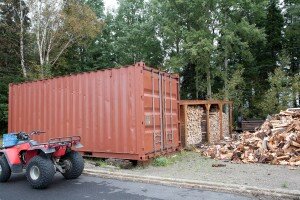To Block or Not To Block—Container Blocking in Detail
To Block or Not to Block - That Is the Question. When buying a shipping container for personal or business use, there are a lot of details to sort out, and proper placement and preparing your foundation is an important one. In this blog, we'll talk about how to successfully prepare your shipping containers' foundation and whether container blocking is the right choice.
What Is Container Blocking?
Shipping container blocking, or bracing, in general, refers to securing and stabilizing the unit. This could be during transport, in a temporary location or in its permanent space. A variety of materials can be used to support and brace a shipping container, but the most commonly used include wood, metal and concrete. In the information covered below, we'll focus mainly on the usage of concrete blocks used at the bottom or foundation of a shipping container to provide a stable and level surface for the container to rest on.

This container was put on blocking

These containers were being filled with heavy equipment, so not blocking was easier
When To Block
Container blocking can be beneficial in situations where the ground is uneven or there is a low-lying area that becomes a puddle after rainfall. Blocking will help to level the container, making it more stable.
Placing your shipping container on blocks can also help with:
- Preventing rust by keeping the container off wet or uneven ground.
- Improving ventilation underneath to reduce moisture buildup.
- Supporting weight evenly to avoid twisting the frame or damaging the floor.
Additionally, if you intend to load the container with partial or heavy loads, this can sometimes cause it to shift slightly. Even a small shift can cause issues and make it difficult to open the doors.
One significant advantage to using blocking to support your shipping container is that, in the event of some shifting in the frame, you can easily place a car jack under one corner and reposition the blocking to allow the doors to open more easily.
When Not To Block
Although blocking can be helpful in many situations, choosing not to block might be a good option for just as many. Some shipping container uses are better suited to having the container sit flat and as flush to the ground as possible. A few of these situations could include:
- If you will be rolling items in and out, or placing the container on a smooth, paved surface like a parking lot.
- If you plan to move pallets or carts into the container or expect frequent foot traffic, keeping the container low can make access easier.
- If you are using the container as a pop-up shop, concession stand, or retail space, especially with a customer-facing window, having it close to the ground improves the experience. Ramps or platforms can still be added if needed.
Even in these scenarios, remember that all containers have about 6" of flooring, so if you are rolling items into your container, you will need a ramp to get them in there.
Preparing For Your Shipping Container's Placement
Properly preparing the area where your shipping container will be placed is essential to ensuring it's secure and well-maintained. A well-prepared area should have a level foundation that prevents structural issues and drainage problems.
Shipping containers weigh a ton, well, actually, they weigh between 2.5 tons and 5 tons, depending on the size and type. Setting a stable foundation and placing your shipping container on blocks when necessary helps prevent the container from sinking into the ground and protects it from damage caused by shifting soil or water accumulation.


Best Shipping Container Blocking to Use
As mentioned, there are several different materials that can be used for blocking and bracing your shipping container. After years of transporting and being involved in the delivery and setup of shipping containers, we recommend using treated lumber or railroad ties. Although a common consideration, we do not recommend cinder blocks as they will disintegrate more quickly. When your container is delivered, be sure to have your blocking handy for the driver to put under your container.
If you intend to place your container on pylons, keep in mind that tiltbed trucks cannot deliver to those locations. Tiltbed trucks need to drive directly into the area where the container will be positioned, as the container is unloaded from the back of the truck.
Learn about Container Delivery Basics: Tilt-Bed, Flat-Bed, or Chassis
How to Put a Shipping Container On Blocks
If you choose to use blocking for your containers, we recommend using 6" x 6" blocks. You can typically find these at lumber yards in 8-foot lengths. Ask the yard to cut the 8-foot lengths into four 2-foot sections. For blocking a 20-foot container, this should suffice. However, for blocking a 40-foot container, you may want to use two sets of these blocks.
Have questions about container blocking or ready to find your perfect shipping container? Connect with our expert team at Super Cubes today for all the details you need.
Super Cubes is a family-owned business located in Minneapolis, MN, that provides containers anywhere in the continental US. We offer personalized service for individuals and businesses, providing high-quality containers at competitive prices. With nationwide facilities, we can modify and deliver containers close to you. Contact our experienced team for your next container project.
Tags:
BlockingJuly 30, 2025

